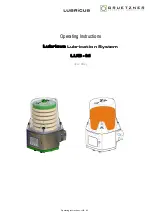
11
When the Faucet is first opened, expect air
and carbon fines (very fine black powder)
from the In–Line Activated Carbon Post
Filter to be rinsed out. This is normal for the
first tank of water or after the In-line filter is
changed.
SECTION IV. OPERATION & MAINTENANCE
A. Normal Operation
1. It is normal for the Total Dissolved Solids
(TDS) of the water to be higher than normal
during the first 5 gallons of operation; this is
due to the sanitizing solution and the new
Post Filters. After this water is rinsed to drain,
the removal rate should stabilize at a value of
greater than 75%.
2. R.O. systems produce drinking water at
relatively slow rates; it can take up to 5 hours
or more to fill the Holding Tank. Normal
operation is to let the Holding Tank fill with
water and then draw water as is needed.
When the pressure in the Holding Tank falls
to a given pressure (as the water is being
used) the Automatic Shut–Off Valve (ASO
Valve) will start water production and the
system will refill the Holding Tank. When the
Holding Tank is full and no water is being
used, the ASO Valve will automatically shut
off the feed water to conserve water. The
more water that is used (up to the capacity
of the system) the better the R.O. system
will function. Other uses for the water are
flowers, pets and rinsing glassware.
With each use it is recommended that you
run the faucet for at least 10 seconds prior to
using water. This is especially important if the
system has not been used daily. After periods
of non–use, such as a week of vacation,
it is better to empty the Holding Tank and
allow the system to produce fresh water for
use. If the system is not used for 3–4 weeks
or longer, it is a good idea to resanitize the
system and to change the prefilter and post
filters.
B. Changing Filters
THIS R.O. SYSTEM CONTAINS FILTERS
WHICH MUST BE REPLACED AT REGULAR
INTERVALS TO MAINTAIN PROPER
PERFORMANCE. USE ONLY FACTORY
APPROVED FILTERS.
All individuals should take adequate
precautions when changing the filters,
including wearing protective gloves, to avoid
direct contact with the exhausted filters.
The recommended interval for changing the
filters (not the R.O. Membrane) is every
6 to 12 months. Typical T.F.C. Membrane life
expectancy is three years. Local conditions may
dictate more frequent changes.
NOTE: If the R.O. Membrane is to be replaced,
see Sec. III, F.1–3 for the proper procedure.
Use a drip pan to catch any water that may spill
when the Filter Housings are removed. Refer to
Fig. 1 for component location.
1. Close the Feed Water Saddle Valve by
turning fully clockwise and open the
Dispensing Faucet. Allow the Holding Tank to
empty.
2. Loosen and remove the Sediment Prefilter
and the Activated Carbon Prefilter Housings.
Discard the filters.
3. Wash the inside of the Housings using a
mild detergent and a soft cloth. Do not use
abrasive cleaners or pads. Thoroughly
rinse all soap from the Housings before
reassembly.
4. To sanitize the system and replace the filters:
NOTE: The system should be sanitized
before installing the Activated Carbon
Prefilter.
•Use a good quality unscented 5¼% liquid
chlorine household bleach.
•Add one capful of bleach (this is 2 tsp. or
10 ml) to the Sediment Prefilter Housing
and install the Sediment Prefilter. AVOID
GETTING BLEACH ON THREADS AND
O-RINGS. Check the Housing O–ring for
proper position in its groove, engage and
firmly tighten the Housing hand tight only.
•Add one capful of bleach to the Activated
Carbon Prefilter Housing. AVOID GETTING
BLEACH ON THREADS AND O-RINGS.
nstall the Housing without the Activated
Carbon Prefilter.
Summary of Contents for T.F.C.-400
Page 13: ...13 NOTES...
Page 14: ...14 NOTES...
Page 15: ...15 NOTES...
Page 18: ...18 MADE IN USA 15 Exploded View Parts List 1 2 3 4 5 6 7 8 9 10 11 12 13 14 16 18 17...






































